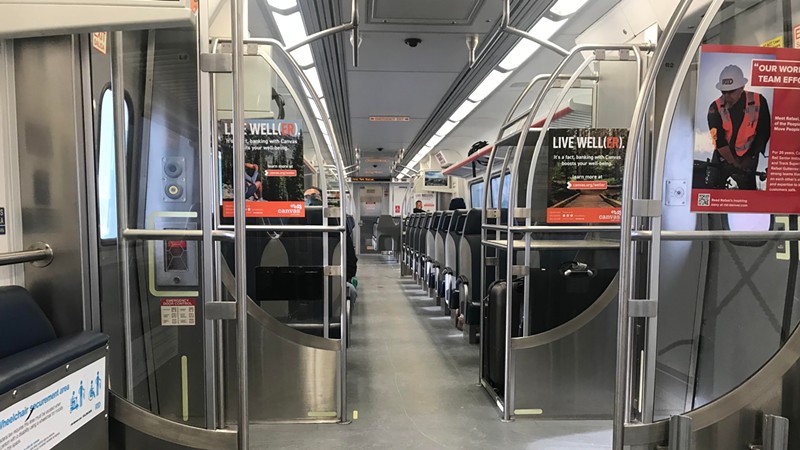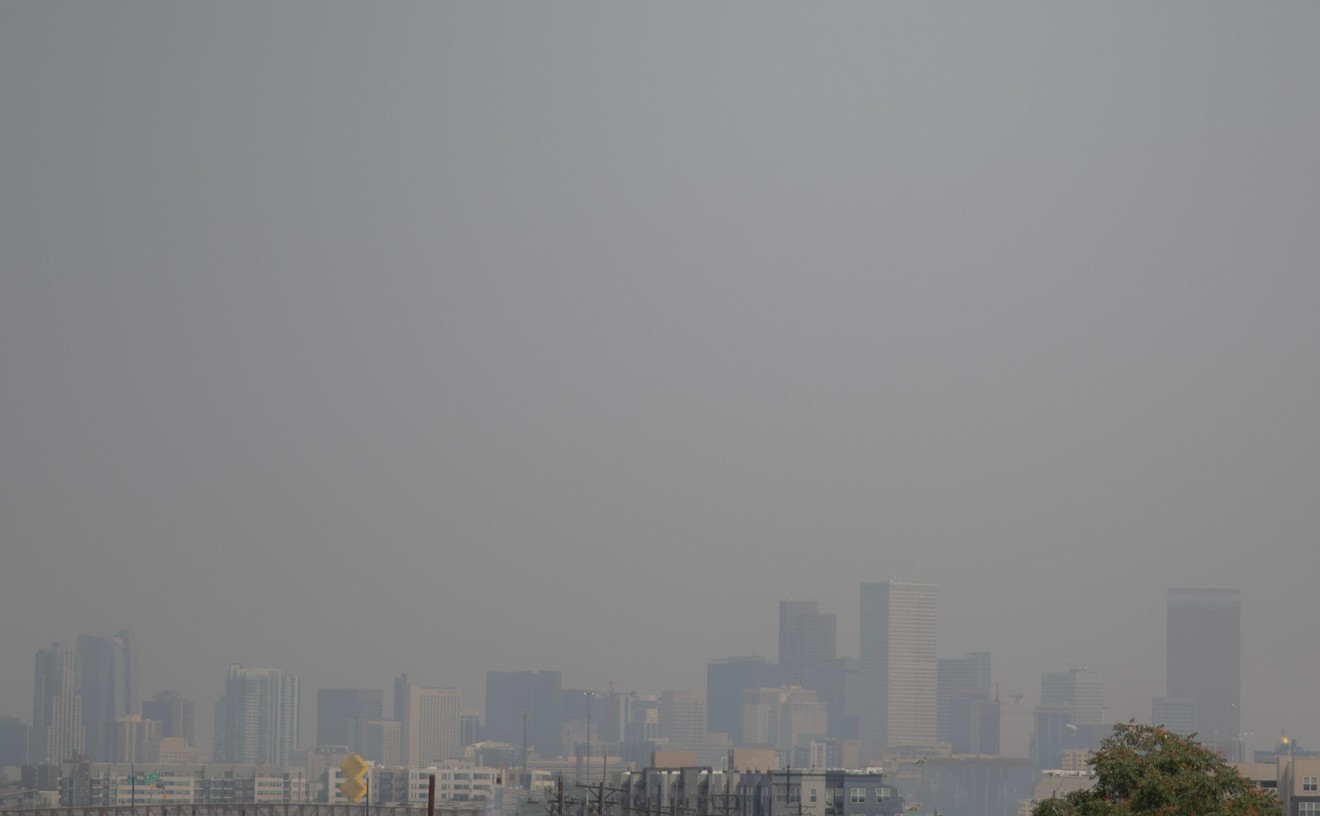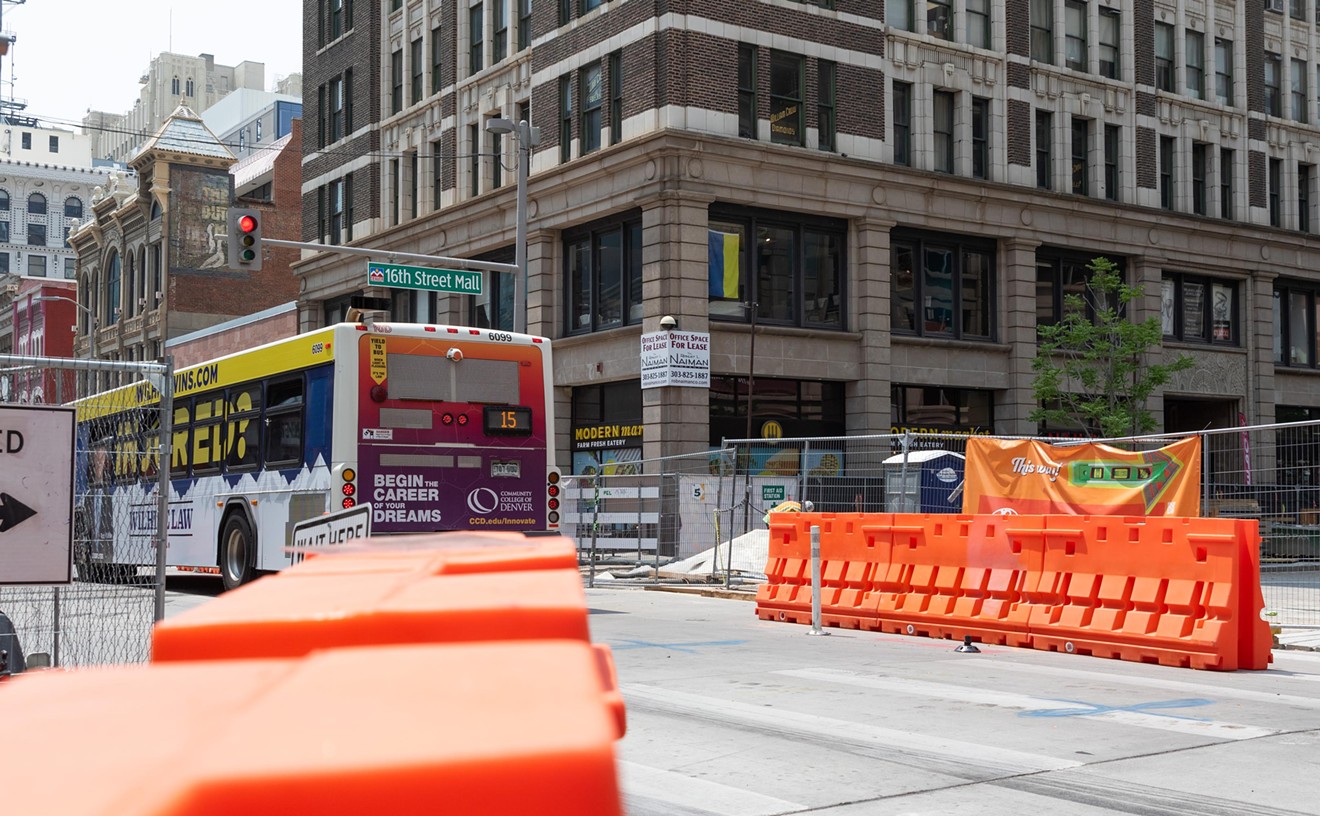Earlier this month, a midday trek on the RTD train officially known as the University of Colorado A Line from Denver International Airport toward Union Station was a breeze. The ticketing process was quick and hassle-free, the price ($10.50) was reasonable, the cars were clean and comfortable, the ride was smooth, and the stops and starts were managed with impressive efficiency.
But very few people were on the train. The most crowded car was perhaps one-third full, and the rest were either almost or entirely deserted. Moreover, only a total of five people climbed aboard at the stations between the airport and 38th and Blake, the last stop before Union Station.
Is the light ridership a problem? Not according to RTD spokesperson Pauline Haberman. "Since it opened for service in April 2016, the University of Colorado A line has exceeded ridership expectations," she insists. "Despite the pandemic, the line continues to exceed expectations, with ridership levels at or above what was estimated for 2025."
The A Line has been controversial from the get-go. Prior to its debut just shy of six years ago, critics complained that it was "convenient to nothing"; in addition to Union Station and 38th and Blake, the train stops at 40th and Colorado, Central Park, Peoria, 40th and Airport Boulevard-Gateway Park, and 61st and Peña. And in the years that followed, breakdowns and delays led to lousy PR — a problem the agency's 2018 claim that the train was 96 percent reliable did little to alleviate.
Since COVID-19 was confirmed in Colorado back in March 2020, RTD as a whole has faced even greater challenges, including service cuts necessitated by ridership shortfalls and charges that the agency wasn't doing enough to enforce masking and other safety protocols. But throughout this period, the A Line tended to be a bright spot, thanks in part to a drop-off in service disruptions. Negative headlines were few and far between, and Haberman notes that "the electrified trains on the line have collectively traveled close to 17.5 million miles — a distance that encompasses more than 36 trips to the moon and back. Average on-time performance for the line in 2020 and 2021 was at 98 percent."
So why does it seem that so few people are using the A Line? Haberman insists this is a matter of perception.
"While the RTD system as a whole has seen a drop in ridership as many commuters pivoted to working from home, University of Colorado A Line ridership has performed better than any other rail lines in the RTD system," she maintains, "especially as the line remains a safe, convenient way to travel to and from Denver International Airport." She adds that "midday is when RTD sees the lowest level of ridership on the line; ridership is much higher in the late evenings."
To support this contention, Haberman provides A Line ridership totals since 2016. According to the agency's data, the train carried more passengers from January to October of 2021 than it did during all of 2020 — though the total remains millions below totals for 2018 and 2019.
Haberman acknowledges that "fares alone do not cover the cost of the University of Colorado A Line, or any of our rail lines." But she says that since "ridership has exceeded expectations since opening, RTD has not experienced any significant challenges in marketing the line to prospective riders. The agency has made a big push across the entire system in recent years to promote mobile ticketing as an easier and more immediate way to purchase tickets for any trip."
At this point, RTD has no plans to add stations to the A Line, and neither is expansion in the offing. "However," Haberman notes, "there are the unfunded FasTracks corridors still in the plans — funding and timing are uncertain at this time. And RTD is about to proceed with a study on one of those: the Northwest Rail Peak Service Plan," which focuses on the northwestern portion of the metro area.
While A Line numbers have been soft since their August 2019 peak — when 744,000 customers, or 24,000 per day, took the train — she stresses that overall, "RTD’s commuter rail services retained 45 percent of pre-COVID-19 ridership numbers — the best in the nation for commuter rail."
Haberman adds: "RTD is currently in the process of reminding/inviting customers back to transit for a wide variety of trips through our 'Take a Trip' campaign. People use RTD for myriad reasons and have varying comfort levels in the midst of a pandemic. When focusing on various destinations, RTD also continues to educate customers about its daily safety and cleaning protocols so customers will be comfortable about returning to transit."
During that midday trip earlier this month, there were no reasons for discomfort — because there just weren't very many people on the train.
[
{
"name": "Air - MediumRectangle - Inline Content - Mobile Display Size",
"component": "12017618",
"insertPoint": "2",
"requiredCountToDisplay": "2",
"watchElement": ".fdn-content-body",
"astAdList": [
{
"adType": "rectangle",
"displayTargets": "mobile"
}
]
},{
"name": "Editor Picks",
"component": "17242653",
"insertPoint": "4",
"requiredCountToDisplay": "1",
"watchElement": ".fdn-content-body",
"astAdList": [
{
"adType": "rectangle",
"displayTargets": "desktop|tablet"
},{
"adType": "rectangle",
"displayTargets": "desktop|tablet|mobile"
}
]
},{
"name": "Inline Links",
"component": "18838239",
"insertPoint": "8th",
"startingPoint": 8,
"requiredCountToDisplay": "7",
"maxInsertions": 25
},{
"name": "Air - MediumRectangle - Combo - Inline Content",
"component": "17261320",
"insertPoint": "8th",
"startingPoint": 8,
"requiredCountToDisplay": "7",
"maxInsertions": 25,
"watchElement": ".fdn-content-body",
"astAdList": [
{
"adType": "rectangle",
"displayTargets": "desktop|tablet"
},{
"adType": "rectangle",
"displayTargets": "desktop|tablet|mobile"
}
]
},{
"name": "Inline Links",
"component": "18838239",
"insertPoint": "8th",
"startingPoint": 12,
"requiredCountToDisplay": "11",
"maxInsertions": 25
},{
"name": "Air - Leaderboard Tower - Combo - Inline Content",
"component": "17261321",
"insertPoint": "8th",
"startingPoint": 12,
"requiredCountToDisplay": "11",
"maxInsertions": 25,
"watchElement": ".fdn-content-body",
"astAdList": [
{
"adType": "leaderboardInlineContent",
"displayTargets": "desktop|tablet"
},{
"adType": "tower",
"displayTargets": "mobile"
}
]
}
]













